- Home
- Max Brooks
The Zombie Survival Guide
The Zombie Survival Guide Read online
Unknown
Zombie Survival Guide
The zombie survival guide : complete protection from the living dead
Max Brooks
Converted to Repligo by FuzzyLogic: Mobile.25u.com
The Zombie Survival Guide is your key to survival against the hordes of undead who may be stalking you right now. Fully illustrated and exhaustively comprehensive, this book covers everything you need to know, including how to understand zombie physiology and behavior, the most effective defense tactics and weaponry, ways to outfit your home for a long siege, and how to survive and adapt in any territory or terrain. Don’t be carefree and foolish with your most precious asset — life. The Zombie Survival Guide offers complete protection through trusted, proven tips for safeguarding yourself and your loved ones against the living dead. It is a book that can save your life.
The zombie survival guide: complete protection from the living dead
Illustrations by Max Werner
For Mom and Dad.
And for Michelle,
who makes life
worth fighting for.
Acknowledgments
First and foremost, thanks to Ed Victor for believing.
To David, Jan, Sergei, Jacob, Alex, Carley, Sara, Fikhirini, Rene, Paulo, and Jiang for the translations.
To Dr. Zane and his team for their field research.
To James “The Colonel” Lofton for his strategic perspective.
To Professor Sommers for the data.
To Sir Ian for the use of his library.
To Red and Steve for their help with the cartography.
To Manfred for a look through an old museum’s basement.
To Artiom for your honesty and courage.
To “Joseph” and “Mary” for making a stranger feel welcome in their country.
To Chandara, Yusef, Hernan, Taylor, and Moishe for the photographs.
To Avi for the transcripts.
To Mason for the footage.
To M.W. for his illustrations.
To Tatsumi for his time and patience.
To “Mrs. Malone” for cutting through the red tape. (THANK YOU!)
To Josene for the tour.
To Tron for a drive by “the place.”
To Captain Ashley and the crew of theSau Tome for proving the point.
To Alice, Pyotr, Hugh, Telly, Antonio, Hideki, and Dr. Singh for the interviews.
To the boys (and girl) at the lab for “you know what.”
To Annik for her brilliance with pen and sword.
And, of course, to all those who have asked to remain anonymous. The lives you have helped to save will be your greatest credit.
Introduction
The dead walk among us. Zombies, ghouls—no matter what their label—these somnambulists are the greatest threat to humanity, other than humanity itself. To call them predators and us prey would be inaccurate. They are a plague, and the human race their host. The lucky victims are devoured, their bones scraped clean, their flesh consumed. Those not so fortunate join the ranks of their attackers, transformed into putrid, carnivorous monsters. Conventional warfare is useless against these creatures, as is conventional thought. The science of ending life, developed and perfected since the beginning of our existence, cannot protect us from an enemy that has no “life” to end.
Does this mean the living dead are invincible? No. Can these creatures be stopped? Yes. Ignorance is the undead’s strongest ally, knowledge their deadliest enemy. That is why this book was written: to provide the knowledge necessary for survival against these subhuman beasts.
Survival is the key word to remember—not victory, not conquest, just survival. This book will not teach you to become a professional zombie hunter. Anyone wishing to devote their life to such a profession must seek training elsewhere. This book was not written for the police, military, or any government agency. These organizations, if they choose to recognize and prepare for the threat, will have access to resources far beyond those of private citizens. It is for them that this survival guide was written—private citizens, people with limited time and resources who nonetheless have refused to be victimized.
Naturally, many other skills—wilderness survival, leadership, even basic first aid—will be necessary in any encounter with the living dead. These were not included in this work, as they can be found in conventional texts. Common sense will dictate what else should be studied to complement this manual. Subsequently, all subjects not directly related to the living dead have been omitted.
From this book, you will learn to recognize your enemy, to choose the right weapons, about killing techniques, and about preparation and improvisation when on the defense, on the run, or on the attack. It will also discuss the possibility of a doomsday scenario, in which the living dead have replaced humanity as the planet’s dominant species.
Do not discount any section of this book as hypothetical drama. Every ounce of knowledge was accumulated by hard-won research and experience. Historical data, laboratory experiments, field research, and eyewitness accounts (including those of the author) have all served to create this work. Even the doomsday scenario is an extrapolation of true-life events. Many actual occurrences are chronicled in the chapter of recorded outbreaks. Studying them will prove that every lesson in this book is rooted in historical fact.
That said, knowledge is only part of the fight for survival. The rest must come from you. Personal choice, the will to live, must be paramount when the dead begin to rise. Without it, nothing will protect you. On the last page of this book, ask yourself one question: What will you do—end your existence in passive acceptance, or stand up and shout, “I will not be their victim! I will survive!” The choice is yours.
The Undead: Myths and Realities
He comes from the grave, his body a home of worms and filth. No life in his eyes, no warmth of his skin, no beating of his breast. His soul, as empty and dark as the night sky. He laughs at the blade, spits at the arrow, for they will not harm his flesh. For eternity, he will walk the earth, smelling the sweet blood of the living, feasting upon the bones of the damned. Beware, for he is the living dead.
ObscureHindu TEXT, CIRCA 1000B.C.E.
ZOM-BIE: (Zom¢be) n.also ZOM-BIES pl.1. An animated corpse that feeds on living human flesh. 2. A voodoo spell that raises the dead. 3. A Voodoo snake god. 4. One who moves or acts in a daze “like a zombie.”
a word of West African origin
What is a zombie? How are they created? What are their strengths and weaknesses? What are their needs, their desires? Why are they hostile to humanity? Before discussing any survival techniques, you must first learn what you are trying to survive.
We must begin by separating fact from fiction. The walking dead are neither a work of “black magic” nor any other supernatural force. Their origin stems from a virus known as Solanum, a Latin word used by Jan Vanderhaven, who first “discovered” the disease.
SOLANUM: THE VIRUS
Solanum works by traveling through the bloodstream, from the initial point of entry to the brain. Through means not yet fully understood, the virus uses the cells of the frontal lobe for replication, destroying them in the process. During this period, all bodily functions cease. By stopping the heart, the infected subject is rendered “dead.” The brain, however, remains alive but dormant, while the virus mutates its cells into a completely new organ. The most critical trait of this new organ is its independence from oxygen. By removing the need for this all-important resource, the undead brain can utilize, but is in no way dependent upon, the complex support mechanism of the human body. Once mutation is complete, this new organ reanimates the body into a form that bears little resemblance (physiologically speaking) to the or
iginal corpse. Some bodily functions remain constant, others operate in a modified capacity, and the remainder shut down completely. This new organism is a zombie, a member of the living dead.
1. Source
Unfortunately, extensive research has yet to find an isolated example of Solanum in nature. Water, air, and soil in all ecosystems, from all parts of the world, have turned up negative, as have their accompanying flora and fauna. At the time of this writing, the search continues.
2. Symptoms
The timetable below outlines the process of an infected human (give or take several hours, depending on the individual).
Hour 1: Pain and discoloration (brown-purple) of the infected area. Immediate clotting of the wound (provided the infection came from a wound).
Hour 5: Fever (99–103 degrees F), chills, slight dementia, vomiting, acute pain in the joints.
Hour 8: Numbing of extremities and infected area, increased fever (103–106 degrees F), increased dementia, loss of muscular coordination.
Hour 11: Paralysis in the lower body, overall numbness, slowed heart rate.
Hour 16: Coma.
Hour 20: Heart stoppage. Zero brain activity.
Hour 23: Reanimation.
3. Transference
Solanum is 100 percent communicable and 100 percent fatal. Fortunately for the human race, the virus is neither waterborne nor airborne. Humans have never been known to contract the virus from elements in nature. Infection can occur only through direct fluidic contact. A zombie bite, although by far the most recognizable means of transference, is by no means the only one. Humans have been infected by brushing their open wounds against those of a zombie or by being splattered by its remains after an explosion. Ingestion of infected flesh (provided the person has no open mouth sores), however, results in permanent death rather than infection. Infected flesh has proven to be highly toxic.
No information—historical, experimental, or otherwise—has surfaced regarding the results of sexual relations with an undead specimen, but as previously noted, the nature of Solanum suggests a high danger of infection. Warning against such an act would be useless, as the only people deranged enough to try would be unconcerned for their own safety. Many have argued that, given the congealed nature of undead bodily fluids, the chances of infection from a non-bite contact should be low. However, it must be remembered that even one organism is enough to begin the cycle.
4. Cross-species Infection
Solanum is fatal to all living creatures, regardless of size, species, or ecosystem. Reanimation, however, takes place only in humans. Studies have shown that Solanum infecting a non-human brain will die within hours of the death of its host, making the carcass safe to handle. Infected animals expire before the virus can replicate throughout their bodies. Infection from insect bites such as from mosquitoes can also be discounted. Experiments have proven that all parasitic insects can sense and will reject an infected host 100 percent of the time.
5. Treatment
Once a human is infected, little can be done to save him or her. Because Solanum is a virus and not a bacteria, antibiotics have no effect. Immunization, the only way to combat a virus, is equally useless, as even the most minute dosage will lead to a full-blown infection. Genetic research is under way. Goals range from stronger human antibodies to resistant cell structure to a counter-virus designed to identify and destroy Solanum. This and other, more radical treatments are still in the earliest stages, with no foreseeable success in the near future. Battlefield experiences have led to the immediate severing of the infected limb (provided this is the location of the bite), but such treatments are dubious at best, with less than a 10 percent success rate. Chances are, the infected human was doomed from the moment the virus entered his or her system. Should the infected human choose suicide, he should remember that the brain must be eliminated first. Cases have been recorded in which recently infected subjects, deceased by means other than the virus, will nonetheless reanimate. Such cases usually occur when the subject expires after the fifth hour of infection. Regardless, any person killed after being bitten or otherwise infected by the undead should be immediately disposed of. (See “Disposal.”)
6. Reanimating The Already Deceased
It has been suggested that fresh human corpses could reanimate if Solanum were introduced after their demise. This is a fallacy. Zombies ignore necrotic flesh and therefore could not transfer the virus. Experiments conducted during and after World War II (see “Recorded Attacks”) have proven that injecting Solanum into a cadaver would be futile because a stagnant bloodstream could not transport the virus to the brain. Injection directly into a dead brain would be equally useless, as the expired cells could not respond to the virus. Solanum doesnot create life—it alters it.
Zombie Attributes
1. Physical Abilities
Too often, the undead have been said to possess superhuman powers: unusual strength, lightning speed, telepathy, etc. Stories range from zombies flying through the air to their scaling vertical surfaces like spiders. While these traits might make for fascinating drama, the individual ghoul is far from a magical, omnipotent demon. Never forget that the body of the undead is, for all practical purposes, human. What changes do occur are in the way this new, reanimated body is used by the now-infected brain. There is no way a zombie could fly unless the human it used to be could fly. The same goes for projecting force fields, teleportation, moving through solid objects, transforming into a wolf, breathing fire, or a variety of other mystical talents attributed to the walking dead. Imagine the human body as a tool kit. The somnambulist brain has those tools, and only those tools, at
its disposal. It cannot create new ones out of thin air. But it can, as you will see, use these tools in unconventional combinations, or push their durability beyond normal human limits.
A. Sight
The eyes of a zombie are no different than those of a normal human. While still capable (given their rate of decomposition) of transmitting visual signals to the brain, how the brain interprets these signals is another matter. Studies are inconclusive regarding the undead’s visual abilities. They can spot prey at distances comparable to a human, but whether they can distinguish a human from one of their own is still up for debate. One theory suggests that the movements made by humans, which are quicker and smoother than those of the undead, is what causes them to stand out to the zombie eye. Experiments have been done in which humans have attempted to confuse approaching ghouls by mimicking their motions and adopting a shambling, awkward limp. To date, none of these attempts have succeeded. It has been suggested that zombies possess night vision, a fact that explains their skill at nocturnal hunting. This theory has been debunked by the fact that all zombies are expert night feeders, even those without eyes.
B. Sound
There is no question that zombies have excellent hearing. Not only can they detect sound—they can determine its direction. The basic range appears to be the same as that for humans. Experiments with extreme high and low frequencies have yielded negative results. Tests have also shown that zombies are attracted by any sounds, not just those made by living creatures. It has been recorded that ghouls will notice sounds ignored by living humans. The most likely, if unproven, explanation is that zombies depend on all their senses equally. Humans are sight-oriented from birth, depending on other senses only if the primary one is lost. Perhaps this is not a handicap shared by the walking dead. If so, it would explain their ability to hunt, fight, and feed in total darkness.
C. Smell
Unlike with sound, the undead have a more acute sense of smell. In both combat situations and laboratory tests, they have been able to distinguish the smell of living prey above all others. In many cases, and given ideal wind conditions, zombies have been known to smell fresh corpses from a distance of more than a mile. Again, this does not mean that ghouls have a greater sense of smell than humans, simply that they rely on it more. It is not known exactly what particular secretion signals the p
resence of prey: sweat, pheromones, blood, etc. In the past, people seeking to move undetected through infested areas have attempted to “mask” their human scent with perfumes, deodorants, or other strong-smelling chemicals. None were successful. Experiments are now under way to synthesize the smells of living creatures as a decoy or even repellent to the walking dead. A successful product is still years away.
D. Taste
Little is known about the altered taste buds of the walking dead. Zombies do have the ability to tell human flesh apart from that of animals, and they prefer the former. Ghouls also have a remarkable ability to reject carrion in favor of freshly killed meat. A human body that has been dead longer than twelve to eighteen hours will be rejected as food. The same goes for cadavers that have been embalmed or otherwise preserved. Whether this has anything to do with “taste” is not yet certain. It may have to do with smell or, perhaps, another instinct that has not been discovered. As to exactly why human flesh is preferable, science has yet to find an answer to this confounding, frustrating, terrifying question.
E. Touch
Zombies have, literally, no physical sensations. All nerve receptors throughout the body remain dead after reanimation. This is truly their greatest and most terrifying advantage over the living. We, as humans, have the ability to experience physical pain as a signal of bodily damage. Our brain classifies such sensations, matches them to the experience that instigated them, and then files the information away for use as a warning against future harm. It is this gift of physiology and instinct that has allowed us to survive as a species. It is why we value virtues such as courage, which inspires people to perform actions despite warnings of danger. The inability to recognize and avoid pain is what makes the walking dead so formidable. Wounds will not be noticed and, therefore, will not deter an attack. Even if a zombie’s body is severely damaged, it will continue to attack until nothing remains.
F. Sixth Sense
Historical research, coupled with laboratory and field observation, have shown that the walking dead have been known to attack even when all their sensory organs have been damaged or completely decomposed. Does this mean that zombies possess a sixth sense? Perhaps. Living humans use less than 5 percent of their brain capacity. It is possible that the virus can stimulate another sensory ability that has been forgotten by evolution. This theory is one of the most hotly debated in the war against the undead. So far, no scientific evidence has been found to support either side.

 World War Z: An Oral History of the Zombie War
World War Z: An Oral History of the Zombie War Minecraft: The Island
Minecraft: The Island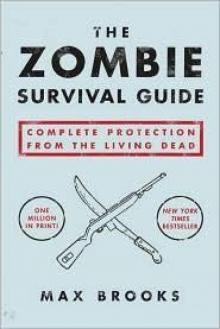 The Zombie Survival Guide: Complete Protection From the Living Dead
The Zombie Survival Guide: Complete Protection From the Living Dead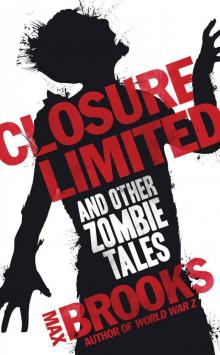 Closure, Limited and Other Zombie Stories
Closure, Limited and Other Zombie Stories Devolution: A Firsthand Account of the Rainier Sasquatch Massacre
Devolution: A Firsthand Account of the Rainier Sasquatch Massacre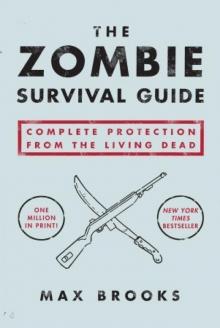 The Zombie Survival Guide
The Zombie Survival Guide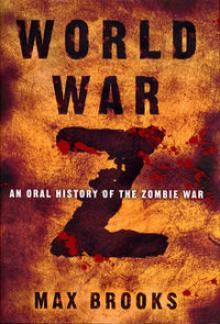 World War Z
World War Z Closure, Limited
Closure, Limited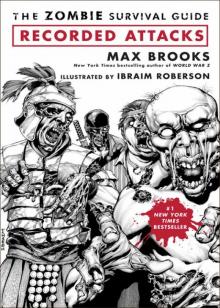 The Zombie Survival Guide: Recorded Attacks
The Zombie Survival Guide: Recorded Attacks World War Z_An Oral History of the Zombie War
World War Z_An Oral History of the Zombie War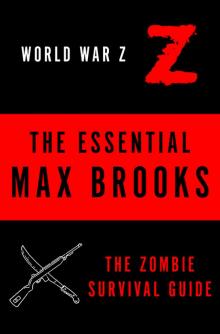 The Essential Max Brooks: The Zombie Survival Guide and World War Z
The Essential Max Brooks: The Zombie Survival Guide and World War Z